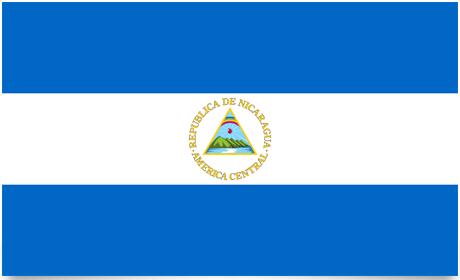Nicaragua Flag and Meaning
Flag of Nicaragua

Nicaragua Flag Meaning
The design of the flag, and also the color choice, has been recurring for Central American states since the first half of the 19th century. It is based on the flag of the Central American Federation with two blue ribbons and in the middle a white, as a symbol of the country’s position between the Atlantic and Pacific Oceans.
The image in the middle of the Nicaraguan flag is their coat of arms. In the triangle, which in itself symbolizes justice, equality and truth, one finds the Jacobin hat and the rainbow, which is hope and freedom. Then you see five volcanoes that represent the nation’s five states. There is a text that runs around the triangle that reads: Republica de Nicaragua – America Central.
Nicaragua Overview
| Population | 5.1 million |
| Currency | Córdoba |
| Area | 130,000 km² |
| Capital city | Managua |
| Population density | 39.2 residents/km² |
| HDI location | 115 |
Nicaragua is Central America’s largest country with coasts facing both the Pacific and the Caribbean. The country is crossed by two mountain systems: the Central American mountain range that runs from northwest to southeast, as well as toward the Pacific a volcanic area with several active volcanoes. Between these mountain ranges are the lakes of Managua and Nicaragua. The climate is tropical with extensive rainfall in the eastern part of the country and drier climate in the western part where most of the population lives. The main export crops are cotton (in the western part of the country) and bananas (in the east).
The People: The majority of Nicaraguans (over 70%) are Masters who are descended from the indigenous population and the Spanish conquerors. 9% of the population is of African origin. A small minority is of European origin and the indigenous population is divided into the groups miskito, sumo and rama.
Religion: Catholic 85%, Protestant 15%.
Language: Spanish (official and the most common). Miskito, Sumo and English are spoken on the Atlantic coast.
Political parties: Frente Sandinista de Liberación Nacional(The Sandinist Liberation Front, FSLN), Movimento Renovación Sandinista (Movement for Sandinist Renewal, MRS), Alianza Política Opositora (Opposition Political Alliance), Former Unión Nacional Opositora (UNO), composed of the parties: Democrático de Confianza Nacional Self-Confidence Party, PDCN); Nacional Conservador (National Conservative Party, PNC); Alianza Popular Conservadora (Conservative Folk Alliance, PAPC); Liberal Independiente (Independent Liberals, PLI); Social Democrat (Social Democracy, PSD); Liberal Constitucionalista (Liberal Constitutional Party, PLC). Other parties: Socialista Nicaragüense (Nicaragua Socialist Party, PSN); Comunista de Nicaragua (Nicaragua Communist Party, PCdeN); Neo Liberal (Neoliberal, PAL); Movimiento Democrático Nicaragüense (Nicaragua Democratic Movement, MDN); the Acción Nacional (National Action Party, PAN); Integracionista de America Central (Central American Integration Party, PIAC); Alianza Nacional Conservadora (Conservative National Alliance, PANC); Popular Social Cristiano (Christian Social People’s Party, PPSC); Movimiento Indígena Yatama (Yatama Movement); Yatama Social Cristiano (Christian Social Yatama Party, PSC); Movimiento Revolucionario Unido (United Revolutionary Movement, MRU); de la Resistencia Nicaragüense (Nicaragua Resistance Party, PRN).
Social organizations: Central Sandinista de Trabajadores (Sandinist National Organization, CST), Confederación de Acción de Unidad Sindical (Confederation of Professional Action Units, CAUS); Confederación General de Trabajadores (CGT-I), Confederación de Trabajadores Nicaragüenses, (CTN); Confederación de Unificación Sindical (CUS); Frente Obrero (Labor Front, FO); Asociación de Trabajadores del Campo (Land Workers’ Association, ATC); Unión Nacional de Empleados (National Union of Employees, UNE); Confederación Nacional de Profesionales (National Association of Professionals, CONAPRO); Union National Agriculturalists and Ganaderos (National Farmers Union, UNAG).
Official name: República de Nicaragua.
Administrative division: 9 regions, 16 departments and 143 municipalities.
Capital: Managua, 1,800,000 residents (2005).
Other important cities: León, 153,200 residents; Chinandega, 120,400 residents; Masaya, 110,000 residents; Granada, 88,800 residents (2000).
Government: Daniel Ortega Saavedra, President since January 2007, re-elected in 2011 and 16. Parliament has one chamber with 92 seats.
National Day: September 15 (Independence Day, 1821). July 19 (Revolution Day, 1979)
Armed Forces: 14,000 Soldiers (2003)













































